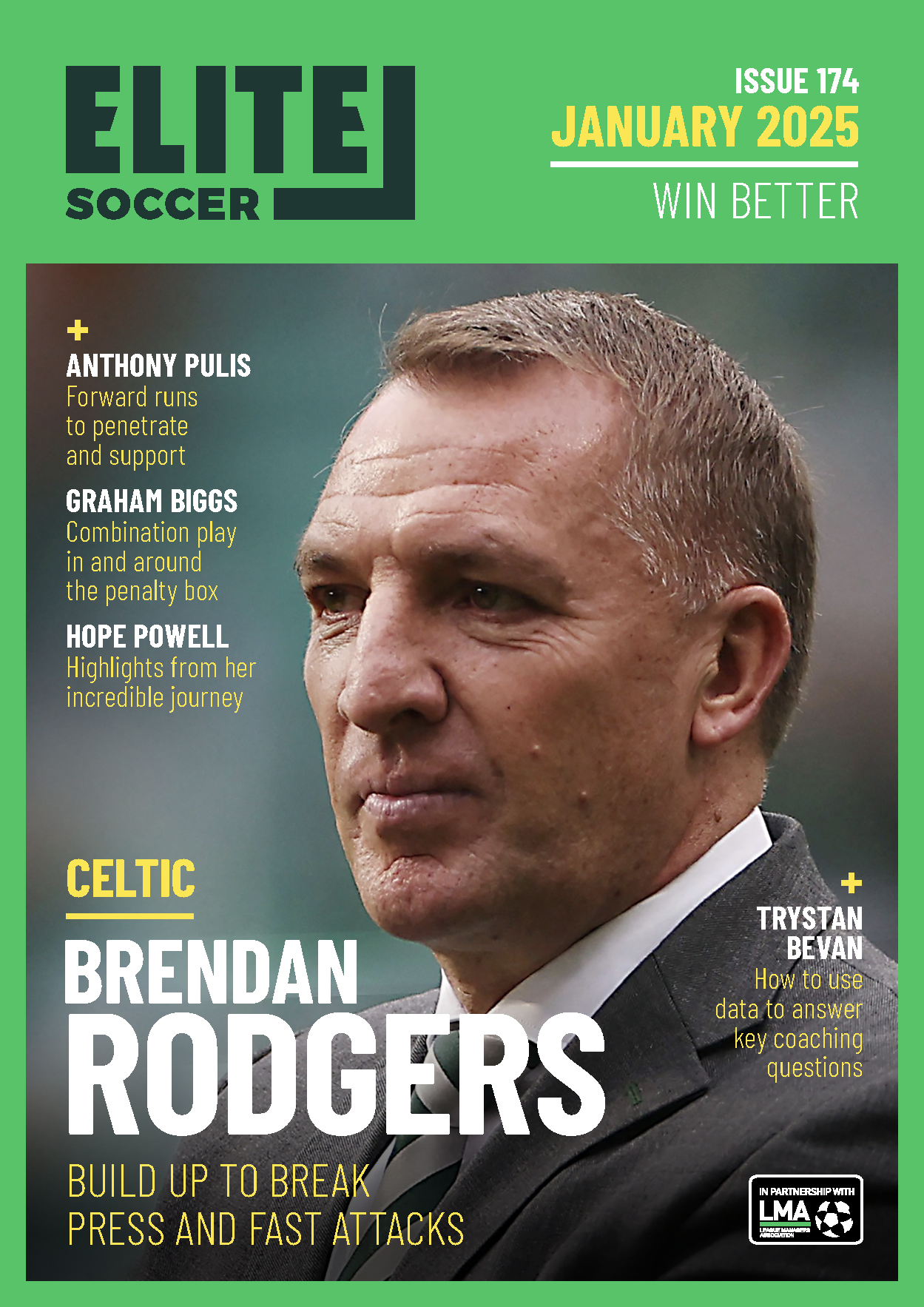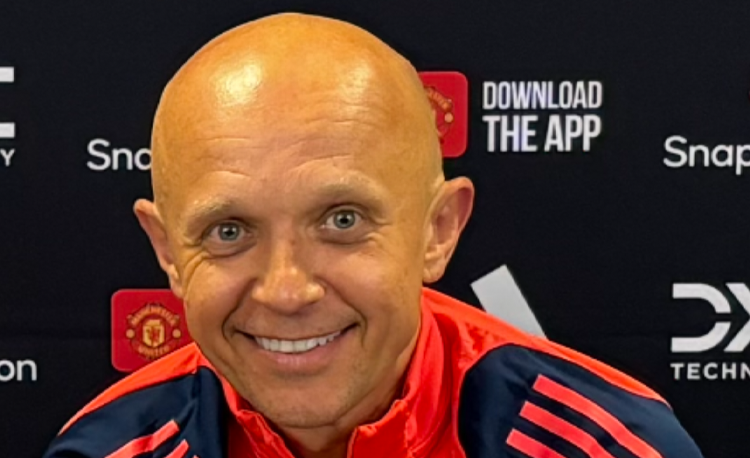You are viewing 1 of your 1 free articles
Primarily, work on the speed of your team’s transition from defence to counter-attack, but also focus on their reaction to losing possession and the speed of recovery when transitioning from attack to defence.
| Area | Up to 60x40 yards |
| Equipment | Balls, bibs, cones, mannequins, 4 goals |
| No. of Players | Up to 20 players + 2 goalkeepers |
| Session Time | Transition possession: 15mins, Defence to attack: 15mins, Quick counter game: 15mins, 4v2 counter-attack game: 15mins, 6v6 counter-attack game: 15mins |
This session not only works on the speed of a team’s transition from defence to counter-attack, but it also focuses on the reaction to losing possession and the speed of recovery when transitioning from attack to defence.
It’s essential that the tempo and intensity of this session is high, as the transitional aspect ensures that players must be reactive to either losing or gaining possession. This intensity, allied to the competitive nature of each activity within the session, means that players will work hard but will really enjoy it.
What do I get the players to do?
Transition possession
We set up an area of 30x30 yards divided into four equal sized boxes, with mannequins along the inside edges of each box, as shown [1a/b]. We’re using eight outfield players divided into a possession team of six and a pressing team of two.
All of the players start in one box and the team of six must string six passes together before they can move into the next box. However, after four passes have been made, two members of the passing team can move into the next box ready to receive the ball, but if the passing sequence breaks down, they must return to their original box.
If the pressers gain control of the ball they should clear it out of the area and play restarts with a ball from the coach to the passing team.
Rotate the pressers every 75/90 seconds.
1a
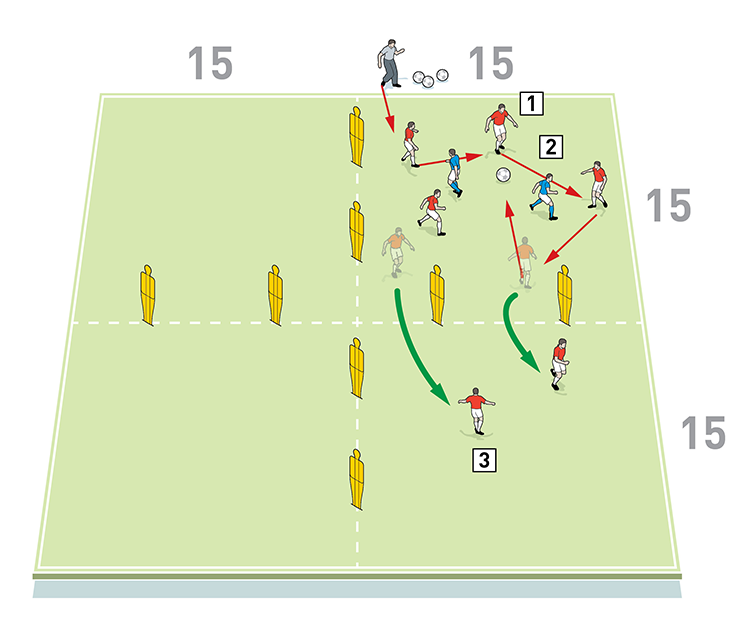
2. The two blues are pressers and must try to win possession and clear the ball
3. After four passes have been made, two of the reds can move into the next box ready to receive. If their team fails to make six passes, they must return to the original box
1b

2. All possession players and pressers now follow the ball into the other box and the possession game continues
Defence to attack
We set up an area of 30x25 yards with a goal and goalkeeper at each end. We’re using six outfield players divided into two teams of three. One player from each team starts in the centre and both teams have wide players on each side of the pitch at the end the team is attacking.
Plays starts with the central red and blue players passing the ball between themselves. On the coach’s shout, one of them attacks the other in a 1v1 and tries to score in the opposition goal, as shown [2]. Just as the attack finishes, the coach calls out for a cross at the other end from the team who have just defended the 1v1. The central players recover, with the player who just defended now becoming the attacker. He must meet the cross at the other end and should try to score in the goal, under pressure from his opponent in the 1v1.
The coaching focus should be the transition from defence to attack. Rotate players so everyone gets a turn in the centre.
2
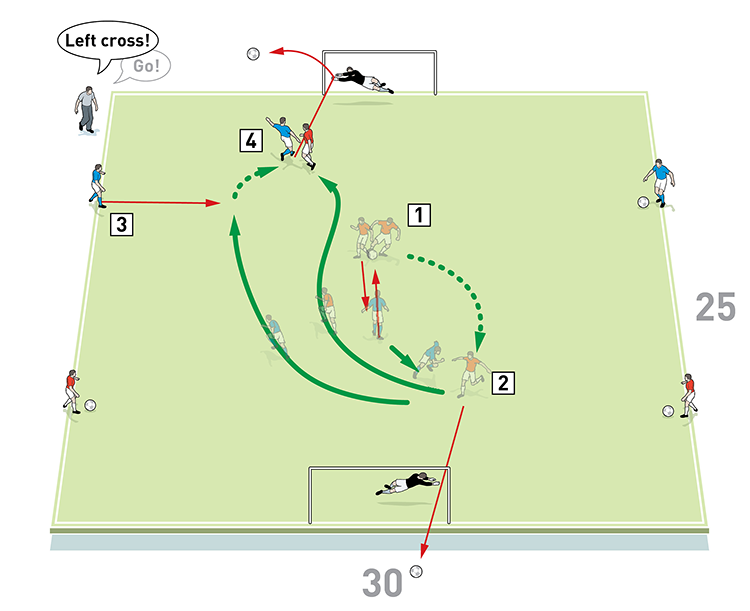
2. On the coach’s call one player attacks the other and tries to score in a 1v1
3. As the first attack finishes, the coach calls for a cross from a wide player at the opposite end
4. The player who had been defending in the 1v1 now meets the cross and attacks the other goal, while his opponent recovers and tries to stop him
Quick counter game
We set up an area of 60x45 yards with two goals at each end. The area is divided into two 15-yard end zones and a 30-yard central zone. We’re using 16 players, divided into two teams of seven and two neutrals. Six players from each team start in the central zone, while one neutral is positioned on each side (goalkeepers can be used as the neutrals). Both teams have a striker in the end zone they are attacking.
Reds start in possession and the aim for them is to string eight passes together, using the help of the two neutral players. Once they have achieved this target, the attackers can play the ball to their striker and break into the end zone to support him, as shown [3]. When the attackers enter the end zone, their opponents can recover into the zone to defend, but players are limited to two touches in the end zone. Touches are unlimited in the central zone.
If the blues win possession at any point, they can immediately counter-attack and should play the ball to their striker, who can then attack one of the goals in the other end zone.
3
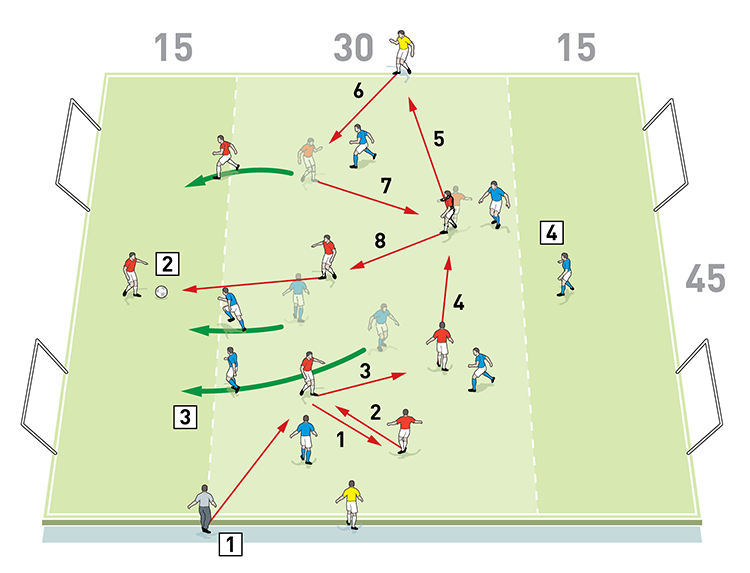
2. The possession team must make eight passes in the central zone before playing to the striker in the end zone
3. Both teams can enter the end zone once the striker receives the ball but touches are limited to two in this zone
4. If the opposition wins the ball they can counter straight away and must try to play to their striker in the end zone
4v2 Counter-attack game
We set up an area of 30x30 yards with a goal and a goalkeeper at each end. We’re using six players, divided into three teams of two.
Two teams line up to attack the third team in a 4v2, as shown [4a]. If possession is lost, or if the ball goes dead, the team last in possession become the new defending pair and must recover to defend the opposite goal from attack, as shown [4b].
The focus of this activity should be on the speed of the counter-attack and the ruthlessness of the finishing.
4a
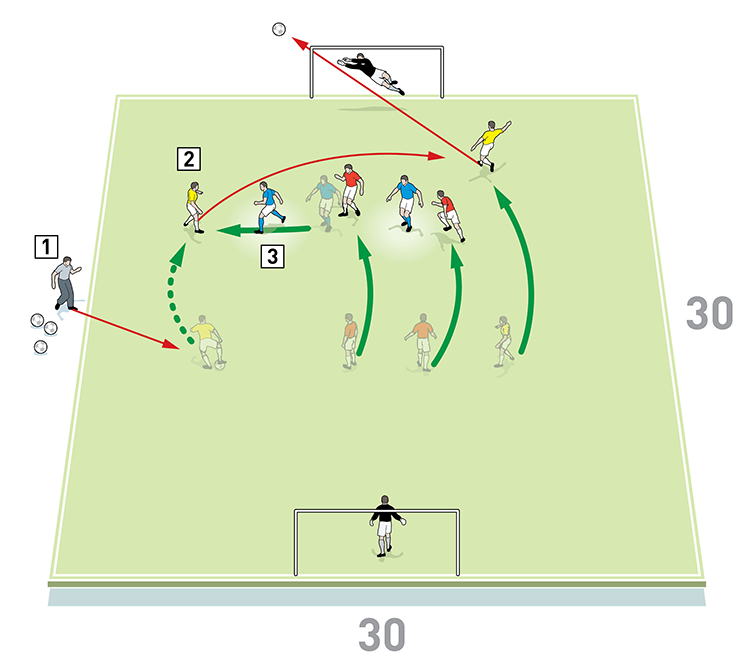
2. Two pairs combine to attack in a 4v2. Here it’s the reds and yellows
3. The defending pair should try to stop the attackers from scoring
4b
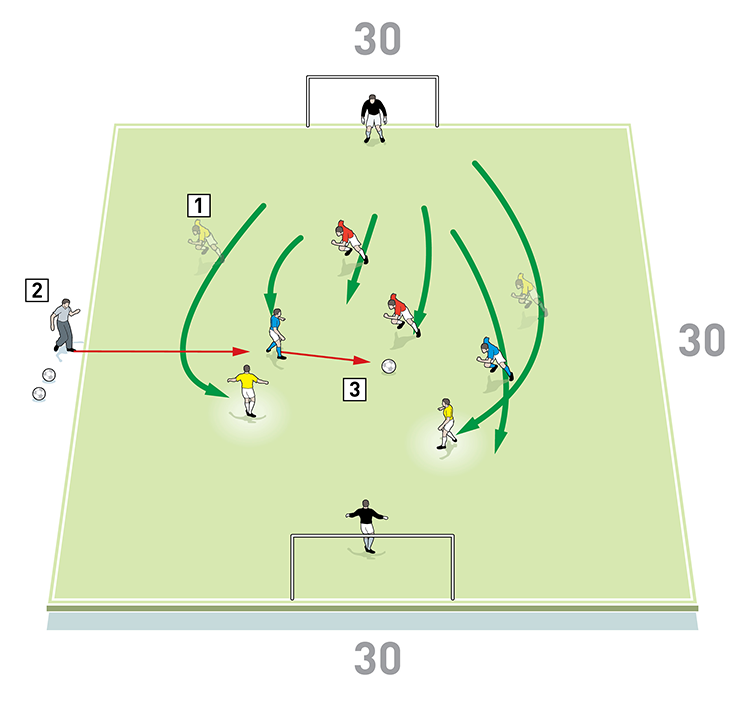
2. The coach quickly plays another ball to the attackers to keep the momentum going
3. The speed of the counter is key to this activity. Here the blues transition quickly between defence and attack
6v6 Counter-attack game
We set up an area of 60x40 yards with a goal and a goalkeeper at each end. We’re using 12 outfield players, divided into two teams of six. The team that starts with the ball leaves one player in its own half and all other players from both teams start in the other half.
Play begins with a pass from the keeper to the player who is in his own half and the possession team (in the diagram, the reds) then must attack the opposite end, as shown [5]. If the reds lose possession, the opposition (the blues) must quickly counter, but all of their players must be in the attacking half of the pitch before they can score. The team who are now defending (the reds) must recover quickly to defend against the counter-attack.
The focus of this activity should be on pressing and making the quick transition to counter-attack.
5
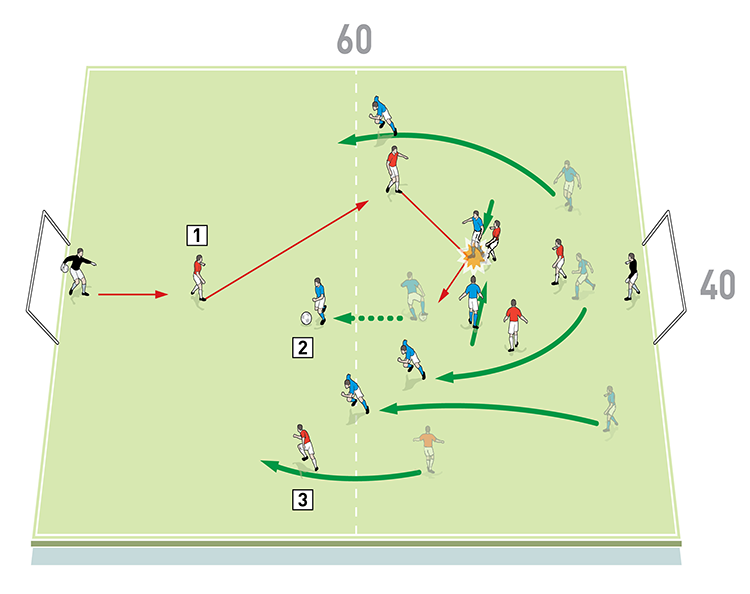
2. The blues press and win the ball. On turnover they must break forward quickly but all of their players must be in the attacking half before they can score a goal
3. The reds must recover quickly to defend against the counter-attack
What are the key things to look out for?
The key points we look for are the speed of reaction as players transition from defence to attack and back to defence. We also want see effective forward passing and good support play when on the counter.
Other key elements to the session are how well we press to counter-attack and how quickly we break forwards when we’re on the counter. The ruthlessness of the players in front of goal is very important too.
What are the typical mistakes players might make and how do I avoid them?
A common problem is that players react well to winning the ball and they will counter quickly, but they don’t always react so swiftly when they lose the ball and are recovering. Coaches must be aware of this and should encourage players to react with speed when making the transition from attack to defence.
Related Files
Editor's Picks
Using the goalkeeper in build-up play
Pressing principles
Intensive boxes drill with goals
Penetrating the final third
Creating and finishing
My philosophy
Pressing initiation
Compact team movement
Defensive organisation
Coaches' Testimonials

Alan Pardew

Arsène Wenger

Brendan Rodgers

Carlos Carvalhal

José Mourinho

Jürgen Klopp

Pep Guardiola

Roy Hodgson

Sir Alex Ferguson

Steven Gerrard
Coaches' Testimonials

Gerald Kearney, Downtown Las Vegas Soccer Club

Paul Butler, Florida, USA

Rick Shields, Springboro, USA

Tony Green, Pierrefonds Titans, Quebec, Canada
Join the world's leading coaches and managers and discover for yourself one of the best kept secrets in coaching. No other training tool on the planet is written or read by the calibre of names you’ll find in Elite Soccer.
In a recent survey 92% of subscribers said Elite Soccer makes them more confident, 89% said it makes them a more effective coach and 91% said it makes them more inspired.
Get Monthly Inspiration
All the latest techniques and approaches
Since 2010 Elite Soccer has given subscribers exclusive insight into the training ground practices of the world’s best coaches. Published in partnership with the League Managers Association we have unparalleled access to the leading lights in the English leagues, as well as a host of international managers.
Elite Soccer exclusively features sessions written by the coaches themselves. There are no observed sessions and no sessions “in the style of”, just first-hand advice delivered direct to you from the coach.



